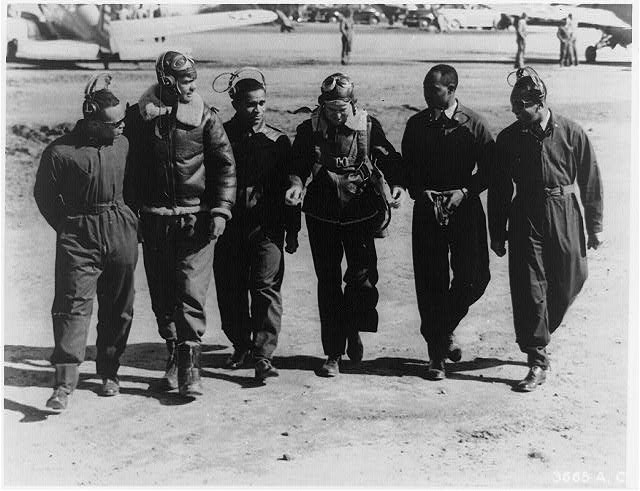Part of a series of articles titled Curiosity Kit: American Aviation History .
Article
Learning From Black Aviation Pioneers

This Curiosity Kit Educational Resource was created by Katie McCarthy, a NCPE intern with the Cultural Resources Office of Interpretation and Education.
Background:
During the 1920s and 1930s Black and white Americans alike dreamed of flying. But Black men and women who were interested in becoming pilots faced barriers that white men and women did not. Early Black pilots often had to earn their license in Europe. Black aviators created their own flight schools and clubs to train others. In the 1930s, the Civilian Pilot Training Programs provided additional opportunities for Black aviators to learn to fly. During World War II, the “experimental” Tuskegee Airmen program trained Black pilots and support staff. You can learn more about the Tuskegee Airmen by visiting the Tuskegee Airmen National Historic Site and by exploring the Travel Sites of American Aviation website.
Objectives:
-
Explore the early history of aviation in the United States.
-
Learn about the challenges Black aviators faced and how they challenged and overcame discriminatory barriers.
-
Identify ways in which we can commemorate the perseverance of Black aviation pioneers.
Inquiry Question:
What motivates you to persevere through challenging situations?
Activity One:
During the early days of flight, dozens of Black men and women received their pilot’s licenses and took to the skies. Some of these aviators are honored at the Tuskegee Airmen National Historic Site. In this activity, choose one or more Black aviators to research. You can find lists of Black aviation pioneers through the Tuskegee Airmen Virtual Exhibit and in the National Air and Space Museum’s Pioneers of Flight Virtual Exhibit, or African American Pioneers in Aviation and Space page. Using these lists as a starting point (or after choosing another individual), consider the following questions regarding the life of a Black aviator:
-
When and where did this person live?
-
What were airplanes like during this period? How did aviation change during this person’s career or lifetime?
-
How did this person become interested in aviation? What motivated them to become involved in aviation?
-
Where did they get their flight training or go to school? Did this person have any friends or mentors who helped them?
-
What kinds of challenges did this person face?
-
What were the important milestones in their career?
-
What is this person’s legacy?
-
Why is this person important to you or to your community?
Activity Two:
The majority of Black aviators were rarely celebrated outside their immediate communities. Today, many people are working to recognize their achievements. When people want to celebrate a person or event, they often build monuments or memorials. There are probably monuments in your community that celebrate people or events who impacted your community.
After exploring the lives of early Black aviators, tap into your creativity to design a monument that honors their achievements, perseverance, and legacy. As you design your monument, consider the following questions:
-
What message or messages do you want your monument to convey?
-
Are you celebrating one aviator in particular, or Black aviators in general? How did you make your decision?
-
What should it look like? What shape should it be? Should it be big or small? What kind of texture it have?
-
Will it have words or symbols on it? Will it depict people or objects? If it will, how will you choose those words, symbols, people, or objects?
-
Where should the memorial be located? Why is this location more important than others?
-
How does this monument compare to other monuments you’ve seen before?
Activity Three:
During their lives and careers, Black aviators persevered against discrimination and broke down barriers to flight. The places associated with them are tangible reminders of that perseverance. Each community has sites associated with overcoming struggle. What are some sites of perseverance in your community? These sites might be tied to a national struggle such as the American Revolution or the desegregation of schools. They might also be tied to smaller, more local struggles such as preserving a historic building or supporting a local business that is struggling. Places of perseverance might even be tied to your own life, such as places where you got over a particular fear or did something challenging.
Pick three to five sites of perseverance to create a “Places of Perseverance” map. As you do so, consider the following questions:
-
What event is tied to this place? Who were the people involved?
-
Has the place remained the same since the event, or has it changed?
-
Who uses this place today?
-
What does this place look like? What does it feel like? What does it smell like? What does it smell like?
-
How do you feel when you are at this place?
-
How does this place help others learn about you or your community?
Tags
- airplane
- pilot
- aviation
- aviation history
- flight
- science and technology
- technology
- african american
- african american history
- african american women
- black history
- tuskegee airmen
- tuskegee airmen national historic site
- mid 20th century
- alabama
- alabama history
- teaching with historic places
- twhp
- educational activity
- curiosity kit
- twhplp
Last updated: May 17, 2023
